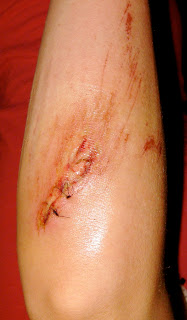Take swimming out of the picture and I am really not that
far off. Why do I keep torturing
myself when I’ve had so many setbacks?
I should have given up the day of my accident and then again the day of
surgery. Nobody would have blamed
me or considered it a failure, not even me. One night my Chinese food revealed a fortune that I took to
heart. ‘You have an ambitious
nature”. I honestly thought
to myself ‘Hell yeah I do’. From
that point on my mantra was to do what I could and see what happens. ‘put yourself in a position so if your
arm cooperates you will be ready’.
My physical therapist didn’t seem to think it was a horrible idea, so all
right, why not? Life is an
adventure and if you allow yourself to roll with it sometimes you will be
amazed of what you’re capable of.
I’m rolling and waiting.
4 months to go
My first bike ride outdoors was a success. The vibration of the road was a bit
rough on the shoulder, but overall it felt good. The next morning I asked my PT if I could start riding my
bike outside and he basically said ‘no’.
Oops! Guess I should’ve
asked first. His primary concern
was falling. I didn’t fall, so all
was good.
3 months to go.
The next 2 months I did not journal a single word. I was too busy training. Looking back I remember a few
things. The day my PT cleared me
to start swimming I swam 2 laps
of breaststroke and my shoulder felt like an ice pick was stabbed into it. 2 days later I swam 4 laps. Before I knew it I was taking my first
crawl stroke and then a month later swimming 2 miles. It really was a blur.
My focused changed from feeling sorry for myself to a shred of hope that
Ironman may actually be possible!!
1 month to go.
My chances were looking good.
I was getting my long rides and runs in and squeaking out the bare
minimum in the pool. 5 miles
into what was supposed to be the longest ride of training I had a split second
lack of concentration and ran my bike off the road. My front tire hit loose gravel and I had to make a quick
decision. Try to ride it out down
the ditch with the possibility of going over the handlebars or lay it
down. I laid it down in a
slow motion pirouette and ended up with a gaping gash on my left forearm. Another ER visit, stitches and
strict orders to not swim for 2-3 weeks due to high risk of infection left me
once again sulking that Ironman was over.
Up until this point I had only swam in the pool. My plan was literally to start open
water swimming the Monday after this ride. I guess not.
The next two weeks I spent my workouts in the gym riding stationary
bikes and trying to keep some strength in my arms with free weights. I relentlessly changed my bandages and
applied the marigold concoction that was prescribed by my naturopath. The days were long with anxiety if
Ironman would be possible.
Stitches came out with 1 week to go and the doctor didn’t tell me I
couldn’t swim. In my mind this was
“my clearance” to swim. The wound
was open, but she prescribed antibiotic ointment and just said “try to keep it
covered in the water”. I had
missed another few weeks of crucial training but was going to make it to that
elusive start line.








